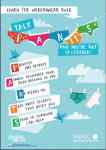
Children and teens are becoming more dependent on social media as a means of communication and entertainment. Very often, developers come up with new apps and include more features in already existing applications, making it difficult to really stay abreast of the world of social media. As parents, it is important to be aware of the popular apps children use, in order to know how to protect and educate them.
Social media refers to the online tools that connect people with common interest, these are applications such as Facebook, Twitter, Instagram… etc. Familiarising yourself with the applications will help you better understand what your children are doing and will help to understand privacy policies to keep them safe, while still allowing them to have fun and interact with friends.
The top 5 apps children use are:
Facebook is currently the world’s largest social network, with over a billion users worldwide. Registered users can create profiles, upload photos and video, send messages to keep in touch with friends, family and colleagues. This year Facebook added new features such as ‘Live stream” and “Facebook story”.
Age Requirement: Facebook requires you to be at least 13 years old to sign up.
Safety Tip: One online safety tip is to get to know your child’s friends on Facebook. Check their friends list for people you don’t know and remind them that they should only interact online with people they know in real life.
For more information see commonsensemedia Facebook review.
Instagram (now owned by Facebook) is a free photo sharing app that allows users to take photos and 1-minute videos with their mobile phones, apply an optional “filter” to the image and quickly share them with friends.
Age Requirement: Instagram requires you to be at least 13 years old to sign up.
Instagram is a great way to keep in touch, but it also presents plenty of opportunity for cyberbullying and inappropriate behaviour. Instagram has implemented several new features this year, like Instagram Stories, and new safety features, like turning off comments on posts.
Safety Tip: If your child has an Instagram account, ensure that the account is private. You can do this by accessing the settings page on your child’s profile.
For more information see A Parent’s Guide To Instagram.
Snapchat
Snapchat is a photo messaging application developed by Stanford University students. Users can take photos, record videos, add text and drawings, and send them to a controlled list of recipients. These sent photographs and videos are known as “Snaps.”
Users set a time limit for how long recipients can view their Snaps, ranging from up to 10 seconds to as little as 1 second, after which – in theory – they will be hidden from the recipient’s device and they are also deleted from snapchat server.
Age Requirement: Snapchat is not intended for children under the age of 13. Minors ages 13-17 should have permission from a parent or legal guardian before using Snapchat. Children under the age of 13 are only permitted to access a special version of Snapchat, called “SnapKidz,” which they are automatically directed to upon sign up.
Safety Tip: If your child has a Snapchat account, it’s important to ensure that a stranger can’t send your child unsuitable images or contact them. To change the settings to ensure that only their friends can send them messages, tap the ghost icon at the top of the screen to access your child’s profile, then tap the gear cog icon in the upper-right corner, under the Settings menu go to “Receive Snaps from…” and ensure that it says “My Friends” instead of “Everyone”.
See also [What Snapchat’s New Feature SnapMap Really Means]
Twitter is an online social networking service that enables its users to send and read text-based messages of up to 140 characters, known as “tweets”.
Age Requirement: Twitter used to be a clear-cut age 13+ to set up an account. Twitter has now changed that. You are no longer asked to enter your birthdate when signing up for an account.
Twitter now uses age screening. Age screening is a way for brands and others to determine online whether a follower meets a minimum age requirement, in a way that is consistent with relevant industry or legal guidelines. This makes it easier for advertisers and others with content not suitable for minors, to advertise on Twitter. Twitter privacy policy does state that their services are not directed to persons under age 13. The age limit continues to be a grey area. Monitoring Twitter is important as it is often a top choice for messaging between teens.
Safety Tip: If your child has a Twitter account, ensure that he/she makes the account private – you can do this by accessing the settings page on your child’s profile, under the settings page, you’ll see “privacy and content”, click on it. when it opens up, click on “Protect my tweets”. After that, the account becomes private and only the people that your child follows can see his/her tweets.
For more Information see commonsensemedia Twitter review.
WhatsApp (now owned by Facebook) is an app that supports sending and receiving a variety of media: text, photos, videos, documents, and location, as well as voice calls. Whatsapp recently introduced a new feature called “WhatsApp story”.
Age requirement: WhatsApp states that you must be at least 13 years old to use their services but it doesn’t make it very clear about the minimum age when signing up. The set up is very simple for a child to follow.
Safety Tip: Since anyone who has your phone number can send you a message on WhatsApp, Inform your child not to give their phone number to people they don’t know. Also, make sure they do not use pictures, that shows they are children, as their profile picture.
For more information see commonsensemedia WhatsApp review.
Pinterest is a pinboard-style photo sharing App that allows users to create and manage theme-based image collections such as events, interests, and hobbies. Users can browse other user’s pinboards for images, “re-pin” images to their own pinboards, or “like” photos.
Age Requirement: You must be at least 13 years old to use Pinterest.
Safety Tip: If your child has a Pinterest account, In the “Account Basics” section, change the “Search Privacy” setting to Yes to keep people from being able to find your child’s account through a search engine such as Google Search, Yahoo Search, or Bing.
For more information see Techboomers Pinterest review.
How to keep your child safe on Social Media
Get online protection for your family
There are free parental control software’s that can help you monitor your children’s activities on social media, block access to potentially dangerous websites and limits your children’s computer usage. These free software’s work on Windows, Mac, iPhones and Android phones.
Do your research
Get to know the social media sites/apps that your children are using. Set up an account, browse around the app, and educate yourself on what each offers and how children are using it.
Be familiar with sites’ age restrictions and know that kids can easily get around them. If you have a child under the age of 13, check the browser history on your computer. If you see a social media site listed, assume your child has created an account. Talk to him/her about why the age requirement exists and how it might be a good idea to hold off on joining. Look into apps that help you monitor your child online.
Keep the line of communication open
Sit down with your child and find out which apps he/she is using, how they work, and whether he/she has experienced any issues on them, such as cyberbullying or contact from strangers. Having an open dialogue will make your child more likely to come to you if he/she is being cyberbullied or harassed online.
Educate your child on social media etiquette
Social media etiquette is very important, there is an appropriate way and manner of speaking to people online, there are also topics and discussions that are off limits such as, family issues, politics, personal information… etc. It is very important that your child is aware that being polite also applies to social media communications.
Set Rules and Limits
Discuss with your child and determine which sites are appropriate to visit, including social media and gaming sites, and set limits on what can be communicated and shared on each one. This includes photos, posts, comments, and anything else that exposes your child’s identity. Consider having access to any accounts your child has set up.
Or, set up an account and insist your child become your “friend” or a part of your network. This will allow you to be aware of any inappropriate behavior that might be going on, and it will also act as a reminder to your child to behave in accordance with the set rules and limits.
Let your child know that it is never okay to meet up with a stranger he/she meets on social media, no matter how long they have been in communication.
Set the Privacy Settings Together
Without proper privacy settings in place, millions of people have access to any photos and information your children posts.
For example, if your child has an unrestricted Twitter or Facebook account, friends of friends (of friends… of friends… you get the idea) can see all photos, status updates, tweets, Instagram photos, and more, that they post.
Additionally, some sites (like Facebook, Snapchat) allow a user’s location to be posted. Since many Facebook users have hundreds (even thousands) of friends, the number of people who can find information on your child’s account can be staggering.
Don’t allow your child’s location to be posted, and warn your child about the safety implications of exposing he/she’s location.
Social media is not all bad, it also has it’s positives and benefits for children such as, it strengthens friendships, it offers a sense of belonging, it helps them express themselves and it gives them a voice. But when it comes to children, it’s safety first above all else. So ensure that while your children are having fun on social media, they are safe and protected.



